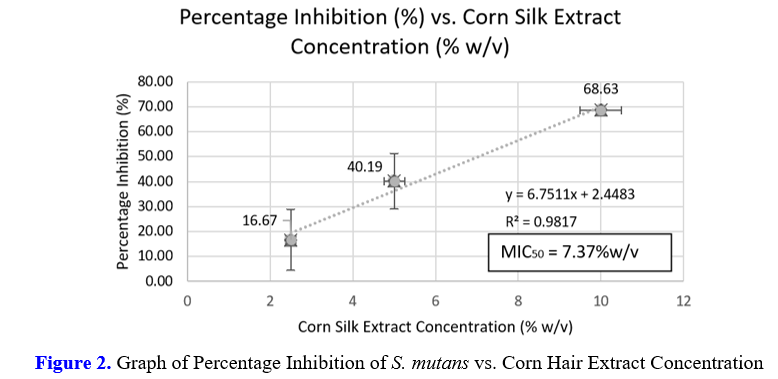Main Article Content
Abstract
Indonesia is undergoing a dental caries emergency with a prevalence of 51.1% (Riskesdas, 2018). This may cause tooth decay due to dental plaque bacteria such as Streptococcus mutans. Mouthwash can be a solution because it has antibacterial properties and reaches interspaces on the teeth. Unfortunately, the active ingredient of mouthwash, chlorhexidine, can cause cancer-related mutations if used continuously. Therefore, it requires alternatives to natural ingredients, such as corn silk. The research aims to determine the corn silk phytochemical profile and minimum inhibitory concentration (MIC) against Streptococcus mutans. The research started by macerating corn silk simplicia using 70% ethanol. Afterwards, thin layer chromatography (TLC) was conducted to determine its phytochemical profile. Disk-diffusion and broth microdilution methods were conducted using various concentrations of corn silk extract to determine its antibacterial activity and minimum inhibitory concentration (MIC) against Streptococcus mutans. Then, the MIC₅₀ was used as the minimum dose of corn silk extract concentration in mouthwash formulation which qualities controlled by pH and organoleptic tests. The yield of corn silk extracted was 16.17%w/w. The phytochemical profile from TLC showed that flavonoids, tannins, and terpenoids were present. Corn silk extract has antibacterial activities against Streptococcus mutans with MIC₅₀ of 7.2%w/v. Corn silk extract, tween 80, sorbitol, sodium benzoate, sodium metabisulfite, oleum menthae piperitae, and distilled water were used in four mouthwash formulas (F1-F4). The pH of all formulas was 5 and the organoleptic test showed that from 30 panelists, the majority chose F2 as the best in terms of taste, color, and smell.
Keywords
Article Details

This work is licensed under a Creative Commons Attribution-NonCommercial 4.0 International License.
References
- Ambarawati, I. G. A. D., Sukrama, I. D. M., & Yasa, I. W. P. S. (2020). Deteksi gen Gtf-B Streptococcus mutans dalam plak dengan gigi karies pada siswa di SD N 29 Dangin Puri. Intisari Sains Medis, 11(3), 1049-1055.
- Balouiri, M., Sadiki, M., & Ibnsouda, S. K. (2016). Methods for in vitro evaluating antimicrobial activity: A review. Journal of pharmaceutical analysis, 6(2), 71-79.
- Fahrurroji, A., & Riza, H. (2020). Karakterisasi ekstrak etanol buah Citrus amblycarpa (L), Citrus aurantifolia (S.), dan Citrus sinensis (O.). Jurnal Farmasi Dan Ilmu Kefarmasian Indonesia, 7(2), 100-113.
- Fajrina, A., Bakhtra, D. D. A., Eriadi, A., Putri, W. C., & Wahyuni, S. (2021). Uji aktivitas antibakteri ekstrak etanol rambut jagung (Zea mays L.) terhadap bakteri Streptococcus mutans dan Porphyromonas gingivalis. Jurnal Farmasi Higea, 13(2), 155-164.
- Hidayanto, A., Manikam, A. S., Pertiwi, W. S., & Harismah, K. (2017). Formulasi obat kumur ekstrak daun kemangi (Ocimum Basilicum L) dengan pemanis alami Stevia (Stevia Rebaudiana Bertoni). URECOL, 189-194.
- Komalasari, W. B., & Si, M. (2021). Analisis Kinerja Perdagangan jagung. Jakarta: Pusat Data dan Sistem Informasi Pertanian Sekretariat Jenderal Kementerian Pertanian, 10.
- Kurnia, S., Yunus, M., & Herawati, N. (2021). Uji Aktivitas Antioksidan Ekstrak Etanol Rambut Jagung (Zea mays L.) dengan Menggunakan Metode 2, 2-difenil-1-pikrilhidrazil (DPPH) Antioxidant Activity Test of Ethanol Corn Hair (Zea mays L.) Extract Using DPPH (2, 2-diphenyl-1-picrylhydrazyl) Method.
- Nurani, F. A., Rejeki, N. R., Setyoputri, T., Wardani, P. K., Ridwan, F. B., Suparmi, S., & Harlisa, P. (2022). The potency of ethanolic extract from corn silk as natural antibiotics for acne-related bacteria: A preliminary study. Bangladesh Journal of Medical Science, 21(1), 84-89.
- Novitasari, A. (2016). Isolasi dan identifikasi saponin pada ekstrak daun mahkota dewa dengan ekstraksi maserasi. Jurnal sains, 6(12).
- Rahayu, Y. P., & Sirait, U. S. (2022, July). Formulasi Sediaan Obat Kumur (Mouthwash) Ekstrak Daun Salam (Syzygium polyanthum (Wight) Walp.) Dan Uji Antibakterinya Terhadap Streptococcus mutans Secara In Vitro. In Prosiding Seminar Nasional Hasil Penelitian (Vol. 5, No. 1, pp. 370-379).
- Rakasiwi, B. L., & Soegihardjo, C. J. (2014). Uji aktivitas antibakteri ekstrak etanolik daging buah buni (Antidesma bunius (L.) Spreng) terhadap Staphylococcus aureus ATCC 25922 dan Escherichia coli ATCC 25923. Jurnal Farmasi Sains dan Komunitas (Journal of Pharmaceutical Sciences and Community), 11(1).
- Riset Kesehatan Dasar. (2018). Laporan Nasional RISKESDAS 2018. Jakarta, Badan Penelitian dan Pengembangan Kesehatan, Kementerian Kesehatan Republik Indonesia.
- Rohmadianto, D., Suhartatik, N., & Widanti, Y. A. (2018). Aktivitas antioksidan teh rambut jagung (Zea mays L. Sacharata) dengan penambahan rosela (Hibiscus sabdariffa L) dan variasi lama pengeringan. JITIPARI (Jurnal Ilmiah Teknologi Dan Industri Pangan UNISRI), 3(2).
- Septiani, V., Choirunnisa, A., & Syam, A. K. (2017). Uji Aktivitas Antimikroba Ekstrak Etanol Daun Karuk (Piper sarmentosum roxb.) Terhadap Streptococcus mutans dan Candida albicans. Kartika: Jurnal Ilmiah Farmasi, 5(1), 7-14.
- Thomas, N.A., Pakaya, M.S., Hutuba, A.H. & Rachmatiyah, Y. (2022). Formulasi Dan Evaluasi Fisik Sediaan Mouthwash Ekstrak Etanol Kulit Buah Matoa (Pometia Pinnata). Journal Syifa Sciences and Clinical Research, 4(2), 523- 529.
- Xie, Y., Yang, W., Tang, F., Chen, X., & Ren, L. (2015). Antibacterial activities of flavonoids: structure-activity relationship and mechanism. Current medicinal chemistry, 22(1), 132-149.
- Yadnya Putra, A. A. G. R., Samirana, P. O., & Andhini, D. A. A. (2020). Isolasi dan Karakterisasi Senyawa Flavonoid Potensial Antioksidan dari Daun Binahong (Anredera scandens (L.) Moq.). Jurnal Farmasi Udayana, 8(2), 90.
- Rahmawati, I. (2021). Uji Aktivitas Sitotoksik Herba Kelakai (Stenochlaena palustris (Burm. F.) Bedd.) terhadap Sel Kanker Hati HEPG2. Jurnal Bioteknologi dan Biosains Indonesia, 8(2), 255-266.
- Yuniarsih, N. (2017). Perlukah Kita Menggunakan Obat Kumur. Majalah Farmasetika, 2(4), 14-17.
